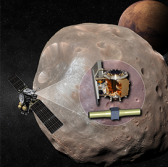
NASA has chosen Johns Hopkins University Applied Physics Laboratory to develop a gamma-ray and neutron spectrometer in support of Japan’s mission to two Martian moons.
JHUAPL said Friday it will work with the Japan Aerospace Exploration Agency to build the MEGANE instrument for the Martian Moons eXploration mission that is set to launch in 2024.
The MEGANE instrument, also known as the Mars-moon Exploration with GAmma rays and Neutrons, will work to measure the surface elemental composition of Phobos and Deimos moons in order to shed light on their formation.
“Solving the riddle of how Mars’ moons came to be will help us better understand how planets formed around our sun and, in turn, around other stars,†said Thomas Zurbuchen, associate administrator for NASA’s science mission directorate.
David Lawrence, an APL space scientist, will oversee the team that will work on the science instrument under the Discovery Program administered by the agency’s Marshall Flight Center in Alabama.
The instrument will feature components from JHUAPL, Lawrence Livermore National Laboratory, Tokyo Institute of Technology and NASA’s Ames Research Center.




